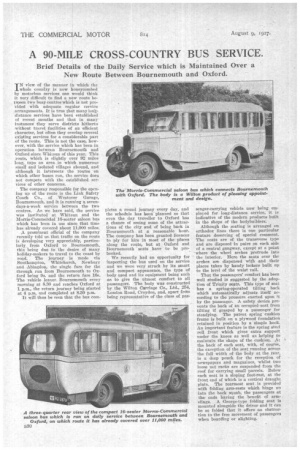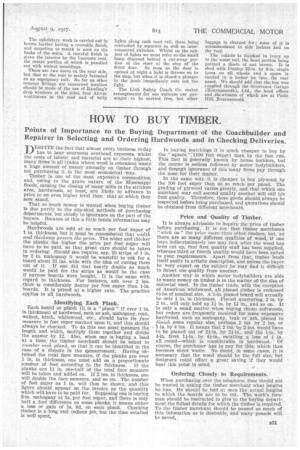A 90-MILE CROSS-COUNTRY BUS SERVICE.
Page 48

Page 49

If you've noticed an error in this article please click here to report it so we can fix it.
Brief Details of the Daily Service which is Maintained Over a New Route Between Bournemouth and Oxford.
IN view of the manner in which the whole country is now honeycombed by motorbus services one would think it very difficult to find a new route between two busy centres which is not provided with adequate regular service arrangements. It is true that many lon'es distance services have beeij eatablisffied of recent months and that in many instances they serve districts hitherto without travel. facilities of an efficient character, but often they overlap several existing services for a considerable part of the route This is not the ease, however, with the service which has been in operation between Bournemouth and Oxford since Whitsun of this year. This route, which is slightly over 92 miles long,. tans an area in which numerous small and isolated villages abound, and although it intersects the routes on which other buses run, the service does not compete with the established services of other concerns.
The company responsible for the open ing up of the route is the Link Safety Coach Co., of Westover Garage, Bournemouth, and it is running a sevendays-a-week service between the two centres. As we have said, the service was instituted at Whitsun pad the Morris-Commercial 16-seater saloon bus which has been in use since that time has already covered about 11,000 miles, A. prominent official of the company recently fold us that traffic on the route is _developing very appreciably, particularly_ from Oxford to Bournemouth, this being due to the desire of many holiday-makers to travel to the coast by road. The journey is made via SsiuthamUten, Whitchurch, Newbury
and .Abingdon, the single fare for the through run from Bournemouth to Oxford being 9s. and the return fare 16s. The vehicle leaves Bournemouth every morning at 8.30 and reaches Oxford at the return journey being started at 4 p.m. arid completed at 8.30 p.m. It will thus be seen that the bus corn
pletes a round journey every day, and the schedule has been planned so that even the day traveller to Oxford has a chance of seeing some of the attractions of the city and of being hack in Bournemouth at a reasonable hour. The company has been granted licences to ply for hire in most of the places along the route, but at Oxford and Bournemouth seats have to be pre booked. .
We recently had an opportunity for inspecting the bus used on the service and we were very struck by its mart and compact appearance, the type of body used and its equipment being such as to give the utmost comfort to all passengers. The body was constructed by the Wilton Carriage Co., Ltd., 254, London Road, Croydon, and, apart from being representative of the class of pas
senger-carrying vehicle now being employed for long-distance service; it is indicative of the modern products built in the shops of the bodybuilders.
Although the seating is arranged on orthodox lines there is one particular feature deserving of special comment. The seats are of the transverse type and are disposed in pairs on each side of a central gangway, except at a point where the wheel arches protrude into the interior. Here the seats over the arches arie dispensed with luid their places taken by handy lockers built up to the level of the waist rail.
That the passengers' comfort has been well studied is suggested by the adoption of Trinity seats. This type of seat has a spring.operated tilting back which automatically adjusts itself according to the pressure exerted upon it by the passenger. A safety device prevents the back of an occupied seat from tilting if grasped by a passenger for steadying. The patent spring -cushion frame is built on a plywood foundation retained in position by a simple hook. An important feature is the spring steel roll front which gives extra support under the knees as well as helping to maintain the shape of the cushion. .At the back of each seat, with, of course, the exception of the seat running across the full width of the body at the rear, is a deep pouch for the reception of newspapers and magazines, whilst two loose net racks are suspended from the roof for carrying small parcels. Below each scat is a sloping foot-rest, at the front end of which is a vertical draught plate. The rearmost seat is provided with folding aria-rests which hinge up into the back squab, the passengers at the ends having the 'benefit of armslings. A George-type folding seat is mounted alongside the driver and it can be so folded that it offers no obstruction to the free movement of passengers when boarding or alighting.
August y, 1927.
• The upholstery work is carried out in brown leather having a crocodile finish, and carpeting to match is used OD the backs of the seats. A tasteful finish is given the interior by the lincrusta roof, the centre portion of which is panelled out with walnut mouldings.
There are two doors on the near side, but that at the rear is mainly intended as an energeney exit. So far as other interior fittings are concerned mention should be made of the use of Rawling's drop windows at the sides, four Airvac ventilators in the roof and of tulip lights along each cant rail, these being controlled by separate as well as, interconnected switches. Whilst on the subject of lights we must refer to the small lamp disposed behind a cut-away portion of the riser of the step of the front door. So soon as the door is opened at night a light is thrown on to the step, but when it is closed a plunger in the jamb immediately cuts out the The Link Safety Coach Co. makes arrangements for one suitcase per passenger to be carried free, but other luggage is charged for; some of it is accommodated in side lockers and on the roof.
The vehicle Is finished in ivory up to the waist rail, the head portion being painted a shade of nut brown. It is shod with Dunlop 32-in. by 6-in, single tyres on all wheels and a spare is carried in a locker let into the rear panel. We should add that the bus was supplied through the Grosvenor Garage (Bournemouth), Ltd., the head offices and showrooms of which are at Poole Hill, Bournemouth.




































































































